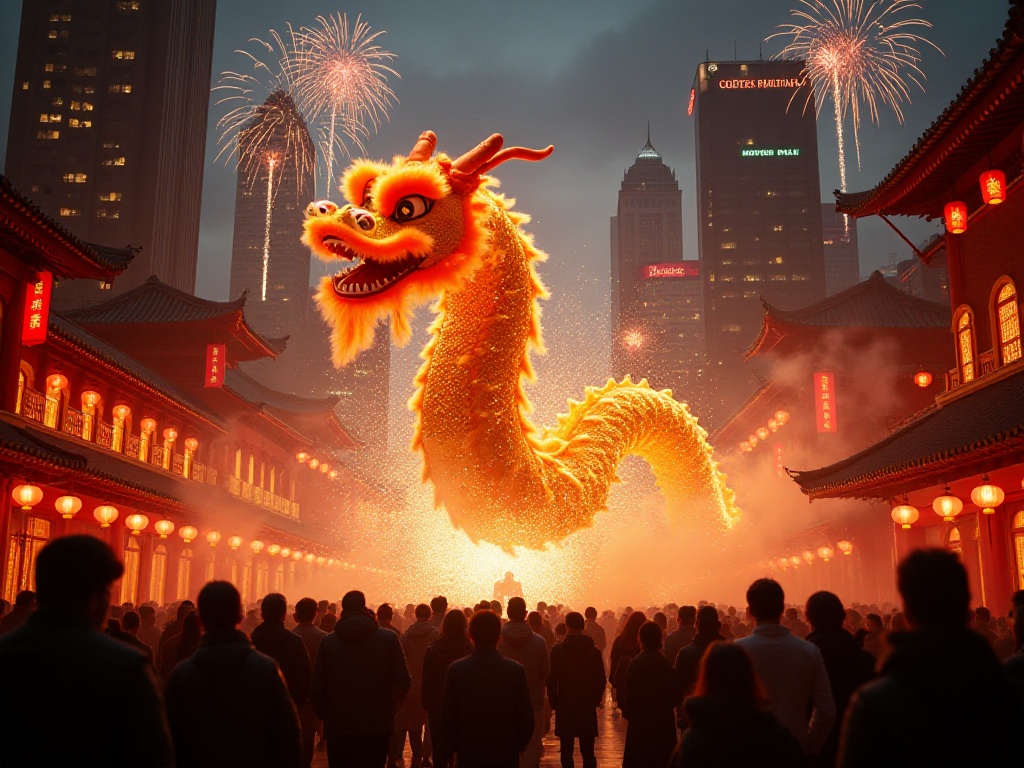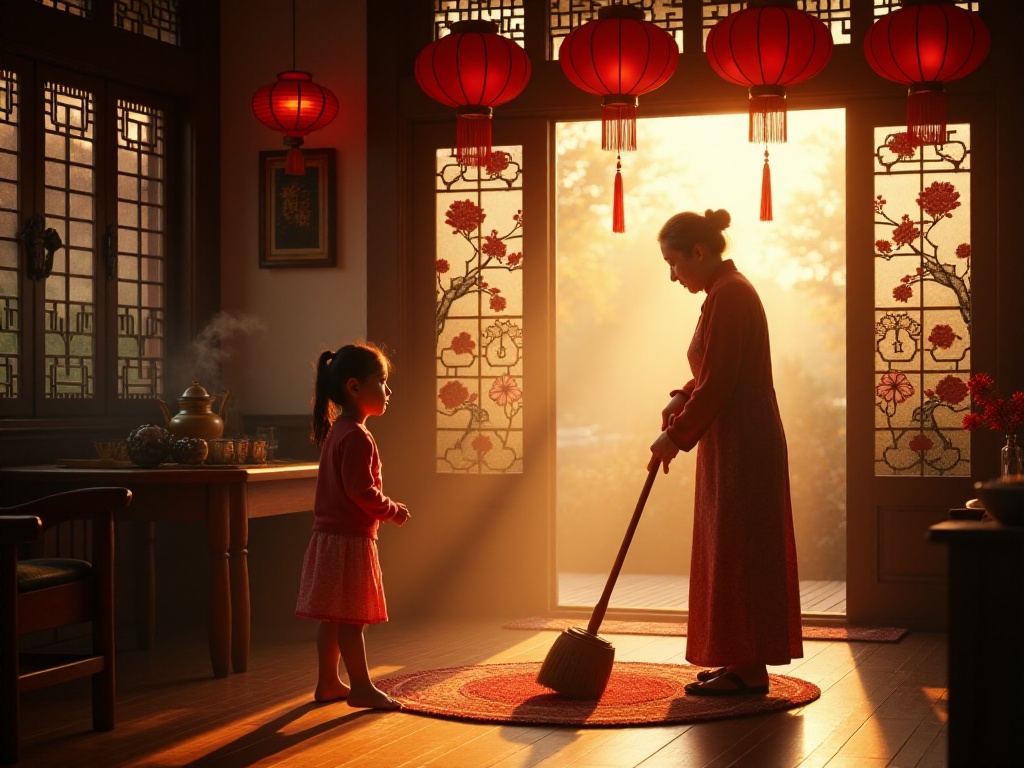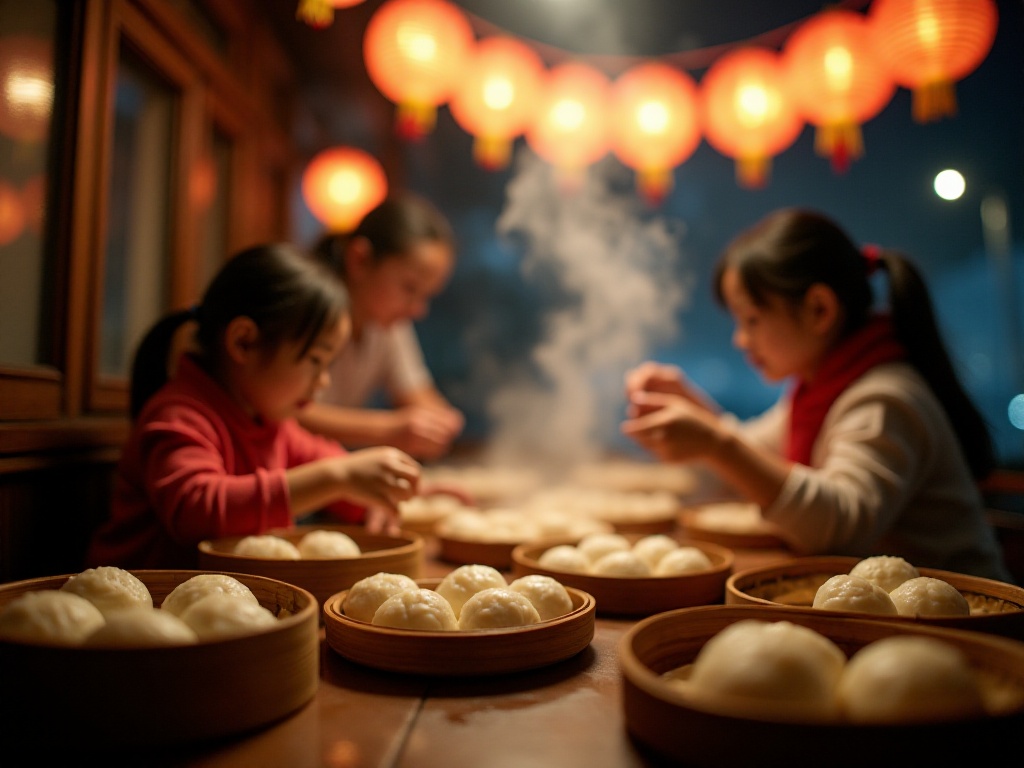Childhood memories of Chinese New Year are always particularly vivid, as if they happened just yesterday. I remember how the entire neighborhood would come alive several days before New Year's Eve. The hallways were filled with cooking aromas from different households, the New Year's goods markets were bustling with people, and long queues formed outside small shops to buy fireworks and firecrackers. Back then, what I looked forward to most was setting off firecrackers with my friends on New Year's Eve and watching colorful fireworks bloom in the night sky.
The scene of grandmother making dumplings remains crystal clear in my mind. She would always start early in the morning, preparing the dough and filling, then gather the whole family to make dumplings together. Her technique was special - the wrappers were rolled thin and uniform, with neat pleats that made your mouth water just looking at them. Looking back, we kids had no idea about dumpling-making techniques, and our dumplings were all crooked and misshapen, but grandmother would always smile and say, "It doesn't matter if they're ugly, they all taste the same in your stomach."
As a native Chinese person, I grew up immersed in this traditional cultural atmosphere. Each festival has its unique sense of ceremony, and behind each custom lies deep cultural significance. Over the years, as I've traveled around, experiencing festival customs from different places, I've grown to appreciate more and more the charm of traditional Chinese festivals. They're not just simple holidays, but cultural treasures that embody thousands of years of civilizational wisdom.
The history of Spring Festival goes back a very long way. As early as the Shang Dynasty, our ancestors had already begun worshipping ancestors and praying for good harvests at the end of the year. People back then believed that only with the blessing of their ancestors could they have abundant grain harvests and thriving livestock in the coming year. This reverence for ancestors and hope for good harvests continues to this day.
In my hometown, visiting ancestral graves on the twenty-ninth day of the twelfth lunar month remains an important tradition. Early that morning, the whole family would bring incense, paper money, and fruit offerings to the ancestral graves. We often met neighbors on the same errand along the way, exchanging greetings and brief conversations. At the graves, the elders would carefully clear weeds around the tombstones, arrange the offerings, light incense, and then the whole family would bow to the ancestors. Though simple, this process is full of remembrance for the deceased and respect for life.
There's quite a lot of preparation work in the twelfth lunar month. Starting from the twenty-third day, every household begins their thorough cleaning. I remember when I was young, my mother would take this opportunity to thoroughly clean every corner of the house. She would make all the windows sparkle, change all the bedding, and not even spare the cobwebs in the corners. Back then I thought my mother was being too particular, but now I understand this wasn't just simple cleaning - it symbolically cleared away the past year's bad luck to make room for the new year.
During this time, neighbors would help each other out. When neighbor Aunt Wang couldn't reach her high windows, my mother would volunteer to help; when we needed to move furniture for cleaning, Uncle Li from next door would come to help. This tradition of mutual assistance filled the entire community with warmth.

When it comes to Spring Festival decorations, there are many particular customs. From the main door to the living room, from windows to balconies, the color red appears everywhere. The big red lanterns at home must be replaced with new ones each year, window paper-cuts must be re-posted, and even the fruit plates on the tea table should be changed to red ones. All this red throughout the house symbolizes prosperity and good fortune.
Speaking of which, I particularly admire those elderly people who can cut window decorations. A few years ago at my grandmother's house, I watched her effortlessly cut out lifelike "Fu" characters and various animal patterns. I tried learning too, but after spending half a day, my cuts were either asymmetrical or missing limbs, and I could only sheepishly paste them in a corner.
Young people today might find these decorations too traditional, but I think it's precisely these New Year-themed decorations that create a strong festive atmosphere. Every time I see the "Fu" character on the balcony, I remember the scene of putting up "Fu" characters with my grandfather when I was young. He would always deliberately paste the "Fu" character upside down, saying that "Fu upside down" sounds like "Fu arrives" in Chinese. After all these years, I still find this custom particularly interesting.

The highlight of Spring Festival is undoubtedly the New Year's Eve dinner. I remember when I was young, everyone in the family would be especially busy on New Year's Eve. Mom and grandmother would be busy in the kitchen preparing various dishes, dad was responsible for buying groceries and decorating the house, while my brother and I would help by washing vegetables and dishes.
The New Year's Eve dinner dishes have special significance. Fish is essential because it represents "having surplus every year"; dumplings are also standard, symbolizing "the exchange of old and new years." Our family had a special tradition of putting coins in some dumplings. That year when my brother got a dumpling with a coin, he was so happy he jumped with joy, and later he really received several school start red envelopes, making us believe even more in this tradition.
Thinking about it now, what's most precious about New Year's Eve dinner isn't how sumptuous the dishes are, but the rare time when the whole family gathers together. At the dinner table, elders would talk about stories from the past, discuss this year's changes, and look forward to next year's hopes. This harmonious atmosphere is something that no delicacy can compare to.

The Lantern Festival is the last festival in the Spring Festival series, and it's one of my favorites. I remember when I was young, the entire city would be decorated with lights and lanterns on this evening. Red lanterns hung along both sides of the streets, each with a riddle written on it. Adults and children would gather under the lanterns, wracking their brains to solve the riddles, and even win small prizes for correct answers.
Those riddles were really interesting, testing both knowledge and thinking ability. For example, "one person walking back and forth" guesses one character, the answer is "往" (wang); "four seasons of clothing" guesses one character, the answer is "裳" (shang). These seemingly simple riddles actually contain the wisdom of the ancients.
Speaking of the Lantern Festival, we can't forget about tangyuan (sweet rice balls). Now you can buy various flavors of frozen tangyuan in supermarkets, but I still miss the ones my grandmother made by hand. She would always start preparing early in the morning, first mixing glutinous rice flour with water to make dough, then rolling it into small balls, and filling them with black sesame or peanut paste. That sweet, soft, and glutinous taste still makes my mouth water when I think about it.

Every Mid-Autumn Festival, the variety of mooncakes can be dazzling. From traditional Cantonese-style mooncakes to trendy snow-skin mooncakes, from single-yolk lotus paste to double-yolk white lotus paste, there are so many varieties it's hard to keep track. But honestly, I still prefer the traditional lotus paste egg yolk mooncakes, which are sweet but not greasy, with a lingering taste.
Last year during the Mid-Autumn Festival, I specifically researched the history of mooncakes. It turns out mooncakes can be traced back to the Yuan Dynasty, when Zhu Yuanzhang used them to hide military orders to organize an uprising. This discovery gave me a whole new appreciation for mooncakes - who knew such a small pastry could carry such historical significance.
Young people today might find mooncakes too sweet and greasy, but I think the significance of mooncakes isn't just about their taste. They're more like carriers of emotion, bearing the homesickness of travelers and the anticipation of family reunions. Every time I receive mooncakes from distant relatives and friends, I can feel their deep affection.
The most beautiful moment of the Mid-Autumn Festival is when the whole family admires the moon together. I remember last Mid-Autumn Festival, our whole family set up a small table on the balcony, made tea, laid out mooncakes and fruit, and chatted while admiring the moon. That warm and harmonious atmosphere is something no luxury restaurant can compare to.

Writing to this point, I can't help but feel deeply moved. These seemingly ordinary festival customs are actually the crystallization of our ancestors' wisdom. They're like an invisible thread, linking thousands of years of civilization, allowing us modern people to experience the charm of traditional culture.
In this fast-paced era, traditional festivals give us a reason to slow down. They remind us that life isn't just about pursuing efficiency and success, but also about cherishing family relationships and enjoying the warmth of reunions. During festivals, no matter how busy work is, I always try to go home to spend time with my parents and continue these beautiful traditions with family.
Actually, the most valuable aspect of traditional festivals is that they can help us find a sense of belonging in our complex modern lives. They tell us that no matter how the world changes, the warmth of family reunions and the charm of traditional culture remain constant.
Everyone has their own unforgettable festival memories. Maybe it's the first snow-skin mooncake you ate as a child, or the first dumpling you made with your grandmother, or the first lantern riddle you solved at the Lantern Festival. These bits and pieces of memories form the warmest parts of our lives.
Let's share these heartwarming traditional festival stories together. In this ever-changing era, let's continue to pass on these precious cultural heritages, letting the warmth of festivals flow forever in the blood of Chinese people.
 Previous
Previous
